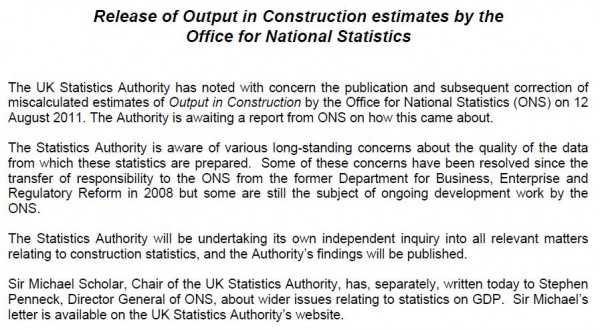Let’s not waste this crisis of confidence over the construction output figures
The Office for National Statistics has come in for yet another beating over the construction figures, this time receiving a stern letter of criticism from the chair of the UK Statistics Authority, Sir Michael Scholar.
I for one am hopeful that this might prompt a full-scale investigation of the construction output stats, which goes beyond the fact that someone got their sums wrong.
 For those who didn’t spot it, on Friday ONS released a set of numbers suggesting q/q growth of 2.3% in construction output.
For those who didn’t spot it, on Friday ONS released a set of numbers suggesting q/q growth of 2.3% in construction output.
This wrong figure came from an adding-up error that was spotted a couple of minutes after the press office pressed the button and the stats went live to the world at 9.30.
It was a school-boy error. The current price figures for March, April and May were added together to produce a second quarter figure for all work of £30.115 billion, rather than April, May and June figures which produce £29.447 billion.
When you run the deflators over the corrected figures and sprinkle in the seasonal adjustments you end up with a q/q rise of 0.5% in total construction output at seasonally adjusted constant 2005 prices, exactly what the statos had estimated when they put together the numbers for the UK GDP figures at the end of July.
So joy dashed.
In no way do I wish to make light of the cock-up in simple sums that appears to have led to the error in the initial release of Q2 construction output figures. But as I know to my frequent embarrassment we all make mistakes.
There was, however, in my view a more serious error made. That was in how the initial mistake was handled.
I became aware that there was a problem pretty soon after the figures were released. Being a bit nerdish I like to understand things and was curious about the data, so I rang up – overcoming any qualms I might have of using the out-of-vogue telephone to communicate.
I was told there may be a glitch, so I dutifully tweeted a health warning suggesting those examining the figures should “hold hard”. I indicated that the published figures probably were an over statement.
What surprised me was how long it took for an official statement to be released saying that there may be a problem with the figures.
By the time the statement came out – after I came back from an early lunch – the incorrect figures had been widely reported.
So a problem became a minor crisis. The revision of construction output growth from 0.5% to 2.3% suggested an increase of 0.1% in the GDP figure for the second quarter – this is pretty big news given that any hint of improvement in the economy is being grasped with unsettling desire.
Now I could criticise the analysts and journalists who followed the numbers out of the window unquestioningly. Surely they should have spotted the error?
Oh what the hell, I may as well and make myself as unpopular as I can with as wide an audience as possible. Yes, they are making comments on the numbers so should have been a bit more curious if not suspicious over the jump from an estimated 0.5% in the earlier GDP release to a published figure of 2.3% (albeit not exactly the same measure).
But in mitigation the demands for 24hr instant news and analysis has left no time for thought and consideration. I certainly make more silly mistakes now than ever. Furthermore, these are official stats and it seems reasonable to assume they are error free. And in fairness the numbers have been revised rather dramatically of late, so a revision of this nature is a bit less surprising as a result.
And in fairness I feel very fortunate that I hadn’t wasted my time trying to make sense of the bogus numbers, coming up with a host of nonsense arguments to justify the sudden rise only to have to retract them seven hours later.
There was a real egg-on-face trap set that was all too easy to fall into.
However the problem with the construction figures in my view goes well beyond a couple of adding up mistakes and is not confined to the current series introduced in January 2010.
I have been highly critical of several aspects of the data series and for a long while now I have been calling for a thorough review. This in my view needs to look at the old series as well as the new series. Indeed there is a strong case for arguing that methodologically the new series is superior.
I could go into lots of complex reasons why the figures present cause for concern.
That they show private housing repair and maintenance in decline since 2003 should be enough to make anyone slightly curious. It may be so, but it seems rather at variance with other signs in the real world.
That the figures suggest the industry was in recession in 2004 and 2005 is also odd. As I noted earlier this week, how come output fell by 5% between 2004 Q1 and 2005 Q4 when the number of jobs rose 6%? That smacks of a productivity crisis.
Naturally for the sport I have developed various pet theories. These keep me amused.
But what I want, and I am not alone here, is for proper resources to be spent on undertaking a thorough and proper inquiry into both the new and old figures for construction output, one that goes beyond process errors.
This will mean spending some money, but it is worth it.
Why, because this data is used as a basis for policy making. And, while good data doesn’t stop the development of crap policies, crap data positively encourages it.